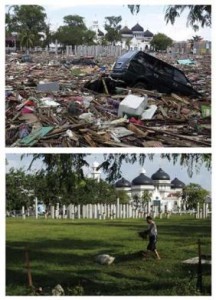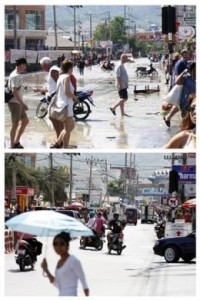By Vincent de Ruiter
Staff Writer
On December 26, 2004, the lives of those who call the Indian Ocean home were dramatically changed in merely seven minutes. The 9.0 magnitude earthquake, with its epicenter in the west coast of Sumatra (an Indonesia island), had as much force as 23,000 Hiroshima atomic bombs. This shift in the tectonic plates outward movement transformed into a tsunami, which struck over sixteen countries, from South Africa all the way to Alaska (a part of the USA), taking the lives of an estimated 230, 000 people and leaving another 1.7 million homeless.
The countries which where the most effected by the earthquake, which account for the most fatalities and displacements, Indonesia, Sri Lanka, and India, together accounting for 96% of the dead and 98% of the displaced. With the impactful events of a decade ago, how has this disaster continued to affect the lives of millions of in South Asia?
Sri Lanka was arguably most affected by the Earthquake. With 30,196 confirmed dead and thousands missing, this natural disaster is one of Sri Lanka’s darkest moments in recent history. The tsunami struck Sri Lanka while the nation was already undergoing a humanitarian crisis, namely the civil war being fought between the Tamil ethnic minor and the Sri Lankan government. The conflict created an obstacle for providing aid, which coupled with the poor infrastructure and poor access to clean water, led to the spread of illness, such as cholera, measles, and diarrhea as well as large scale crop destruction. The crisis lead to the deaths of several thousand more.
In the ten years since the earthquake, Sri Lanka has also had several achievements.  Thanks to the immediate outpouring of international aid from around the world, Sri Lanka was among the first nations to receive help. With an end to the twenty-six year civil war in 2009, access to clean drinking water has now been assured to 92% of the population and the agricultural sector is producing again, ultimately leading to a low unemployment rate of 5.1%. However, even now in 2014 there is still a high rate of disease and infection, especially diarrhea and hepatises A, and Sri Lankan children suffer from the highest rate of malnutrition among children in the world. Sri Lanka is still a developing nation, but the rapidity with which the country has been able to grow since the earthquake speaks to the spirit of the Sri Lankan people.
Thanks to the immediate outpouring of international aid from around the world, Sri Lanka was among the first nations to receive help. With an end to the twenty-six year civil war in 2009, access to clean drinking water has now been assured to 92% of the population and the agricultural sector is producing again, ultimately leading to a low unemployment rate of 5.1%. However, even now in 2014 there is still a high rate of disease and infection, especially diarrhea and hepatises A, and Sri Lankan children suffer from the highest rate of malnutrition among children in the world. Sri Lanka is still a developing nation, but the rapidity with which the country has been able to grow since the earthquake speaks to the spirit of the Sri Lankan people.
India is another one of the areas most affected by the earthquake. Among the hardest  hit were the islands of Nicobar, which lost around 1/5of its population and the island of Chowra, which lost 2/3 of this population. Mainland India, was also struck by the tsunami and its aftershock on it Southern coast, causing an additional 3,000 deaths. Unlike the Sri Lankan recovery effort, the Indian recovery effort was largely domestic, and India sent aid to its people with relative speed and efficiently. Within hours of the disaster, the Indian Military was responding to hit areas with needed goods, within days the government created a special recovery fund and offered ex-gratia payment to those who lost kin. In addition, the Indian infrastructure, made it easier for Non-Governmental Organizations (NGOs), such as the International Red Cross, to reach those in need.
hit were the islands of Nicobar, which lost around 1/5of its population and the island of Chowra, which lost 2/3 of this population. Mainland India, was also struck by the tsunami and its aftershock on it Southern coast, causing an additional 3,000 deaths. Unlike the Sri Lankan recovery effort, the Indian recovery effort was largely domestic, and India sent aid to its people with relative speed and efficiently. Within hours of the disaster, the Indian Military was responding to hit areas with needed goods, within days the government created a special recovery fund and offered ex-gratia payment to those who lost kin. In addition, the Indian infrastructure, made it easier for Non-Governmental Organizations (NGOs), such as the International Red Cross, to reach those in need.
However, it was the Indonesian island of Sumatra that suffered the most damage and was one of the last to receive international aid. In fact, so many Sinatra regional government officials died in the quake that the national Indonesian government declared that the regional Aceh government had been “crippled.” As a result, there were few means to distribute the piles of incoming aid among affected citizens. The weak infrastructure meant it took almost eleven days for aid to reach survivors, in some cases. Alongside the disaster, soldiers stationed in areas hit were under attack from separatist groups fighting for independence from Indonesia, such as the Free Aceh movements, causing further delay in distribution.
Ten years later, it is difficult to truly evaluate the effectiveness of Sumatra’s attempts to recover from the natural disaster. Indonesia has since faced similar earthquakes, but an improvement in the infrastructure led to a much more expeditious delivery of aid.
Despite the limited ability of the people of South Asia to fully recover from the deadly force in 2004, the attempt to rebuild has both strengthened the ability of affected nations to coordinate regional and international endeavors to allow for disaster response and has also strengthened the will of some of the most brave people in the world, as the threat of future tsunamis is ever present.
Vincent de Ruiter, class of 2015, is a Politics and Anthropology major from Minneapolis, Minnesota, United States.
